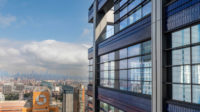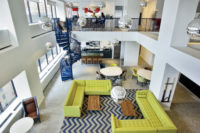Whether taking an automobile for a spin or attending workshops at the Apple Store, test drives have helped the modern consumer understand innovation. Gensler, too, has applied trial runs to its workplace business. When moving its own staff into a new office, the global design firm treats that space “as a laboratory that demonstrates our principles and our research,” says Andy Cohen, co-CEO of the company with Diane Hoskins.
Gensler has put itself on the frontline of workplace evolution since it began officially researching the subject 15 years ago. After Cohen and Hoskins approve a lease, the local workplace-design team will translate guiding principles and other proprietary knowledge—most notably, metrics from a firm-generated survey tool called the Workplace Performance Index—to that site. Gensler’s most recent offices represent a common vision of open, daylight-infused spaces where square footage once allotted to individual workspaces is now distributed among focused tasks, collaboration, and other activities. They also center on zones that can accommodate all-hands events.
The firm’s various projects are not cut wholly from the same cloth. The Denver studio, which opened last year, is finished in a palette of wood, metal, and raw concrete that evokes the city’s historic mining economy and its outdoorsy culture. Meanwhile, an office inaugurated in Costa Rica at about the same time celebrates the tropical climate with an expansive hammock- and furniture-filled terrace. Cohen says that, in addition to aesthetic decisions, lease pricing can also differentiate the new studios. For example, the Los Angeles and Washington, D.C., offices that opened in 2011 and 2013 respectively both feature a three-story atrium and stadium seating, while such large-scale gestures are constrained in the 2-year-old New York and forthcoming London locations, where real estate is more expensive.
Regional discrepancies aside, the analytics from one effort do inform the next. Cohen explains, “We have a variety of work environments, like stand-up tables and conference rooms, that people can choose to occupy on a given day. What we continue to tweak is the area dedicated to open collaborative space.” Gensler researchers are detailing the acoustical needs of focused work, in particular: “We’re finding that unless you have conference space placed very close to the open environment, people will simply meet in the open environment.” Other areas of continual improvement concern videoconferencing technology and maximizing the community outreach of ground-floor spaces.
Aside from deepening its knowledge of workplace design, “It’s a marketing tool,” Cohen says of Gensler’s real-estate initiative. “In L.A., where I sit, we give three to five tours a day. Our existing clients appreciate that we demonstrate leadership in the workplace, and there’s no doubt new clients are coming to our space all the time.” The executive says that experiencing a Gensler studio, seeing how it works to foster productivity and employee recruitment, can inspire them.
Cohen also notes that it would be difficult to peg physical environment as the sole impetus for growth, but he does say that the buzz generated by the Los Angeles office contributed to the company’s expansion in that market from 280 to more than 600 employees since 2011 and that, more widely, the 16 office moves Gensler undertook between 2010 and 2015 helped double its total employee count to more than 5,000. Another indication of the positive effects of this strategy: last year Gensler was the only architecture firm that earned a spot on Glassdoor’s 50 Best Places to Work; as Cohen puts it, “This kind of metric focuses on the well-being of people, and that’s what we focus on in our workplace design.”
Back to Good Design Is Good Business 2016
PeopleFind expanded credits and specifications for each location here.
Architect: Gensler — Andy Cohen, Diane Hoskins, co-CEOs
Engineers: Los Angeles: Nabih Youssef (structural); Levine Seegel, Glumac (m/e/p); Oakland: Integral Group; Denver: Martin/Martin (structural); C3S (electrical); VH Engineering (m/p)
General Contractors: Oakland: Turner Construction; Denver: Provident Construction
Client: Gensler
Size: Los Angeles: 38,700 square feet; New York: 25,000 square feet; Oakland: 24,000 square feet; Denver: 23,000 square feet; Costa Rica: 15,800 square feet
Cost: withheld Completion dates: Los Angeles: 2011; New York: 2014; Newport Beach: 2013; Oakland: January 2015; Denver: April 2015; Washington, D.C.: 2013; Costa Rica: 2015
|
ProductsCurtain wall: Denver: Tubelite
Los Angeles: Metcoe (skylights); Denver: Viracon
Denver: Klein (glass office fronts); Modernfold (movable glass walls); Washington, D.C.: Transwall, Adotta
Fans: Costa Rica: Big Ass Fan
Los Angeles: USG; Oakland: Armstrong; Washington, D.C.: Whisper Walls, Barrisol
Furnishings: Los Angeles: Vitra, Herman Miller, Knoll; New York: Knoll, Humanscale, Blu Dot; Oakland: MASH Studios, Knoll, Herman Miller; Costa Rica: Kimball, Steelcase, Vitra, Kusch, Coalesse; Denver: Watson, Knoll, Bernhardt, Herman Miller, Vitra, Halcon, B&B Italia
New York, Costa Rica: Interface; Oakland: Tandus Centiva; Denver: Tandus, Shaw
Lighting: Los Angeles: The Lighting Quotient; Oakland: Fluxwerx, Zumtobel; Denver: Fluxwerx, Selux, Flos, Gotham, Focal Point Lights, Finelite, Delta Light, Juno, Zomtobel, Vibia, Prudential Lighting, Lutron; Costa Rica: Flos
Oakland; Washington, D.C.: Lutron
Oakland: IdeaPaint; Denver: Benjamin Moore
Denver: Carnegie, Designtex, BuzziSpace, Knoll (textiles) |


















Post a comment to this article
Report Abusive Comment